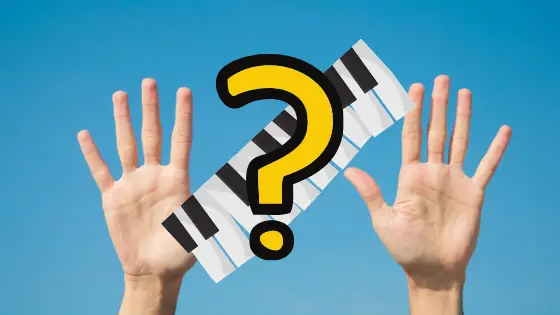Are you a beginner struggling with piano playing?
Do you wonder, “How do you separate piano hands?”
Don’t feel bad at all!
Honestly, this is the most difficult part of piano playing and one everyone struggles with until they get to the highest levels of play.
As a music teacher, I wanted to help my students get good at piano, so I made this guide for how to play piano with two hands.
Learning to play piano with separate hands takes patience and practice. It’s mostly all about developing coordination and independence. Still, if you go about this in a sequential and proven way, you’ll end up learning faster overall.
Look ahead for the steps needed to learn two-hand piano and tips for putting it all together.
Table of Contents
Steps For Learning How To Play Piano With Two Hands
One Hand At A Time
The first step is to get your hands comfortable playing simple melody lines, usually using only five notes next to each other.
Do a simple melody with your right hand. Then, do the exact same pattern/melody with your left hand.
Alternate the hands playing the line as smoothly as possible until you switch between them without a hitch.
A good song for this would be Hot Cross Buns or Mary Had A Little Lamb.
Two Hands Doing The Same Thing
The next step to playing piano with two hands is to put the hands together playing the exact same thing.
Take the same simple line or melody (or another easy one) and play it with both hands at the same time.
If you spent a lot of time on the first step, you’ll notice this one doesn’t take as long.
However, for those of you who skip ahead, slow yourself down and make sure you’re familiar with each step.
Two Hands Mirroring Each Other
Once you’re able to get both hands going at the same time, the next level is to mirror your hands.
In this stage, your fingers are technically moving the same way, but directionally, they’re opposite.
It’s as if someone placed a mirror between your hands. They look like they’re moving the same, but when one is moving higher, the other is moving lower in the same way.
For example:
Place both thumbs on middle C.
Learn how to memorize piano keys.
The right hand should have their fingers on C, D, E, F, and G. (Thumb, Index, Middle, Ring, Little).
The left hand should have their fingers on C, B, A, G, and F. (Thumb, Index, Middle, Ring, Little).
With both hands playing at the same time, play in this order:
Thumb → Index → Middle → Ring → Little → Ring → Middle → Index → Thumb
Or for those who prefer piano fingering numbers (which is better):
1 → 2→ 3 → 4 → 5 → 4 → 3 → 2 → 1
The mirroring motion stretches the brain-finger coordination.
Play A Song With The Melody Shared Between Both Hands
Another similar step is to have a single melody with the notes shared between both hands. The left hand is responsible for some notes and the right hands is responsible for other notes.
They don’t take turns playing the exact same thing, but by switching between them they do one single song or exercise.
This works to unite the piano playing even though they’re not playing the same thing.
At this point, you’re ready to play piano with two hands more independently.
Note: A good piano program will cycle through all of these steps through increasingly difficult and complex music. These steps are never truly “finished”, and professional piano players still practice these kinds of activities all the time (although at a much higher level).

5 Tips For How To Play Piano With Two Hands Doing Different Things
#1 Start Simple
Don’t dive into playing hard music with two hands. It’ll only cause frustration.
If you want to play a more complicated song and chip away at learning it, go for it!
But make sure you balance with easier material to build your basic skills.
Start with 3 note songs, then move to 5 note songs.
The left hand can play simple block chords or maybe a single note at a time.
#2 One Hand At A Time
When learning a new song or part, it’s difficult for anyone, even good piano players, to play both hands perfectly at the same time.
The first thing you need to do is play each hand on their own. Practice their parts individually until it’s second nature and you won’t have to think much to play them.
Then, put them together.
#3 Move From Slow To Fast
“If you can’t play it slow, you can’t play it fast.”
My private lesson teacher in college drilled this into me.
And it’s true!
There’s nothing wrong with playing the song slowly at first. Eve professionals do this to make sure they have the correct fingerings.
Put on a metronome at 60 BPM. Practice slowly until you play it correctly three times in a row.
Bump the tempo (speed) up to 70 BPM. Repeat until you’re at the speed you want to play it at.
#4 Focus On One Hand
There’s always one hand you find is easier to play than the others. For most people (including myself), this is the right hand.
The left hand is the one giving people the most trouble.
When you put the hands together, direct more of your attention to what your struggling hand is doing. Trust your good hand to know what it’s doing almost subconsciously.
Focus on how the notes of the struggling hand fit in with the good hand.
You’d be surprised how well this trick works.
Of course, this only works if you did step #2 a lot.
#5 Forgive Yourself
Playing piano is rewarding, but using two independent hands is difficult at times. Any time you start a new song, it’s hard.
But trust me, over time, your brain will start to notice patterns in how the hands fit together.
You’ll come across songs with similar structure and pick them up faster and easier.
But you won’t get there if you give up.
Forgive yourself for struggling. It’s the only way to improve!
Final Thoughts
Now you know a little more about how to play piano with two hands. Hopefully this guide helps you see how the process develops your coordination.
Most good books and piano programs will guide you through this process and give you great exercises for building your skill.
One of the problems with most of these books is that there isn’t a lot of built-in motivation to keep learning.
This is why I recommend Flowkey to my students. The list of over 1,500 songs organized into playing levels and fun courses all levels piano playing is just fun to go through.

